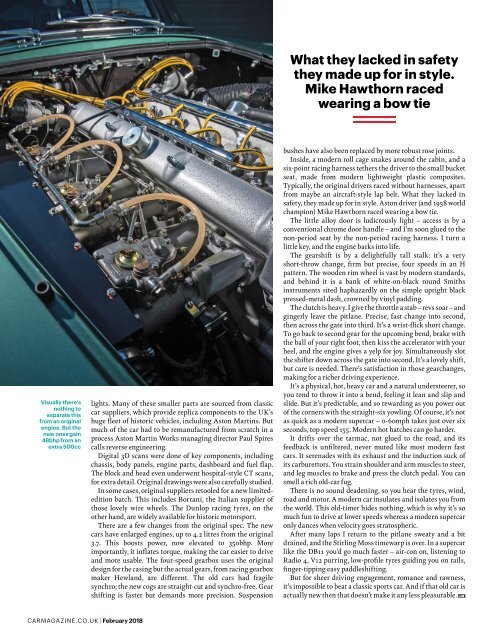You also want an ePaper? Increase the reach of your titles
YUMPU automatically turns print PDFs into web optimized ePapers that Google loves.
What they lacked in safety<br />
they made up for in style.<br />
Mike Hawthorn raced<br />
wearing a bow tie<br />
Visually there's<br />
nothing to<br />
separate this<br />
from an original<br />
engine. But the<br />
new ones gain<br />
48bhp from an<br />
extra 500cc<br />
lights. Many of these smaller parts are sourced from classic<br />
car suppliers, which provide replica components to the UK’s<br />
huge fleet of historic vehicles, including <strong>Aston</strong> Martins. But<br />
much of the car had to be remanufactured from scratch in a<br />
process <strong>Aston</strong> Martin Works managing director Paul Spires<br />
calls reverse engineering.<br />
<strong>Digital</strong> 3D scans were done of key components, including<br />
chassis, body panels, engine parts, dashboard and fuel flap.<br />
The block and head even underwent hospital-style CT scans,<br />
for extra detail. Original drawings were also carefully studied.<br />
In some cases, original suppliers retooled for a new limitededition<br />
batch. This includes Borrani, the Italian supplier of<br />
those lovely wire wheels. The Dunlop racing tyres, on the<br />
other hand, are widely available for historic motorsport.<br />
There are a few changes from the original spec. The new<br />
cars have enlarged engines, up to 4.2 litres from the original<br />
3.7. This boosts power, now elevated to 350bhp. More<br />
importantly, it inflates torque, making the car easier to drive<br />
and more usable. The four-speed gearbox uses the original<br />
design for the casing but the actual gears, from racing gearbox<br />
maker Hewland, are different. The old cars had fragile<br />
synchro; the new cogs are straight-cut and synchro-free. Gear<br />
shifting is faster but demands more precision. Suspension<br />
bushes have also been replaced by more robust rose joints.<br />
Inside, a modern roll cage snakes around the cabin, and a<br />
six-point racing harness tethers the driver to the small bucket<br />
seat, made from modern lightweight plastic composites.<br />
Typically, the original drivers raced without harnesses, apart<br />
from maybe an aircraft-style lap belt. What they lacked in<br />
safety, they made up for in style. <strong>Aston</strong> driver (and 1958 world<br />
champion) Mike Hawthorn raced wearing a bow tie.<br />
The little alloy door is ludicrously light – access is by a<br />
conventional chrome door handle – and I’m soon glued to the<br />
non-period seat by the non-period racing harness. I turn a<br />
little key, and the engine barks into life.<br />
The gearshift is by a delightfully tall stalk: it’s a very<br />
short-throw change, firm but precise, four speeds in an H<br />
pattern. The wooden rim wheel is vast by modern standards,<br />
and behind it is a bank of white-on-black round Smiths<br />
instruments sited haphazardly on the simple upright black<br />
pressed-metal dash, crowned by vinyl padding.<br />
The clutch is heavy. I give the throttle a stab – revs soar – and<br />
gingerly leave the pitlane. Precise, fast change into second,<br />
then across the gate into third. It’s a wrist-flick short change.<br />
To go back to second gear for the upcoming bend, brake with<br />
the ball of your right foot, then kiss the accelerator with your<br />
heel, and the engine gives a yelp for joy. Simultaneously slot<br />
the shifter down across the gate into second. It’s a lovely shift,<br />
but care is needed. There’s satisfaction in those gearchanges,<br />
making for a richer driving experience.<br />
It’s a physical, hot, heavy car and a natural understeerer, so<br />
you tend to throw it into a bend, feeling it lean and slip and<br />
slide. But it’s predictable, and so rewarding as you power out<br />
of the corners with the straight-six yowling. Of course, it’s not<br />
as quick as a modern supercar – 0-60mph takes just over six<br />
seconds, top speed 155. Modern hot hatches can go harder.<br />
It drifts over the tarmac, not glued to the road, and its<br />
feedback is unfiltered, never muted like most modern fast<br />
cars. It serenades with its exhaust and the induction suck of<br />
its carburettors. You strain shoulder and arm muscles to steer,<br />
and leg muscles to brake and press the clutch pedal. You can<br />
smell a rich old-car fug.<br />
There is no sound deadening, so you hear the tyres, wind,<br />
road and motor. A modern car insulates and isolates you from<br />
the world. This old-timer hides nothing, which is why it’s so<br />
much fun to drive at lower speeds whereas a modern supercar<br />
only dances when velocity goes stratospheric.<br />
After many laps I return to the pitlane sweaty and a bit<br />
drained, and the Stirling Moss timewarp is over. In a supercar<br />
like the DB11 you’d go much faster – air-con on, listening to<br />
Radio 4, V12 purring, low-profile tyres guiding you on rails,<br />
finger-tipping easy paddleshifting.<br />
But for sheer driving engagement, romance and rawness,<br />
it’s impossible to beat a classic sports car. And if that old car is<br />
actually new then that doesn’t make it any less pleasurable.<br />
CARMAGAZINE.CO.UK | February 2018



